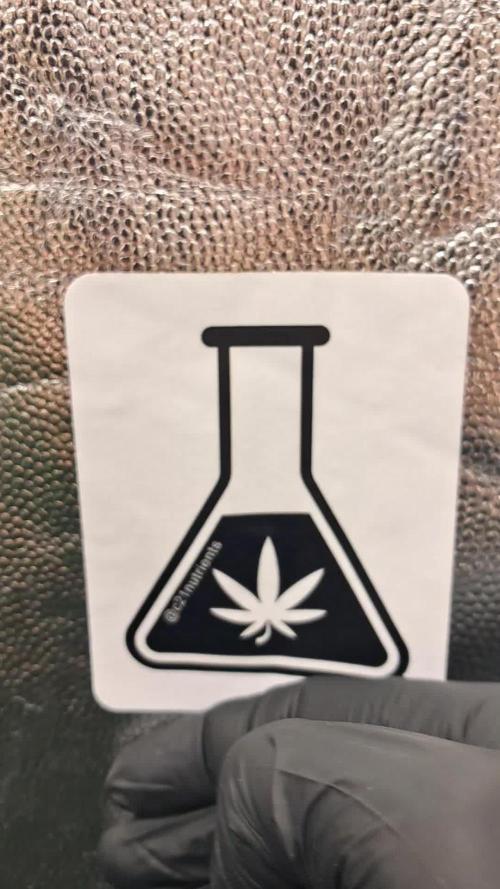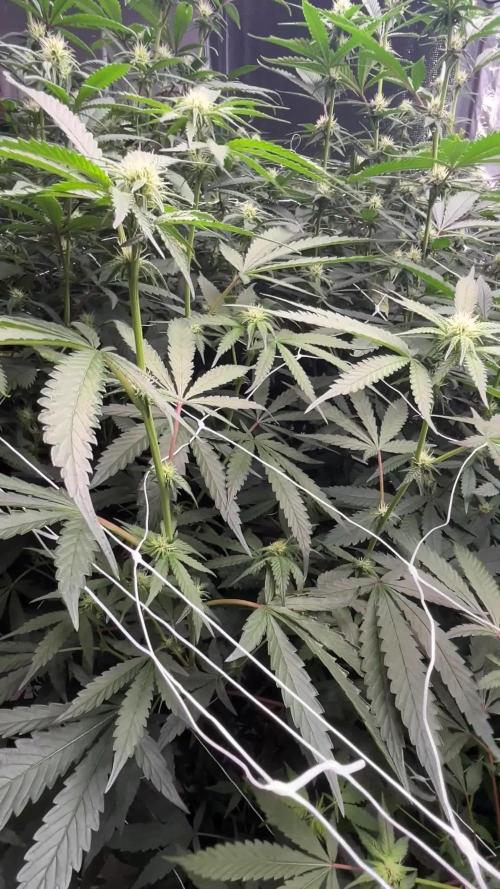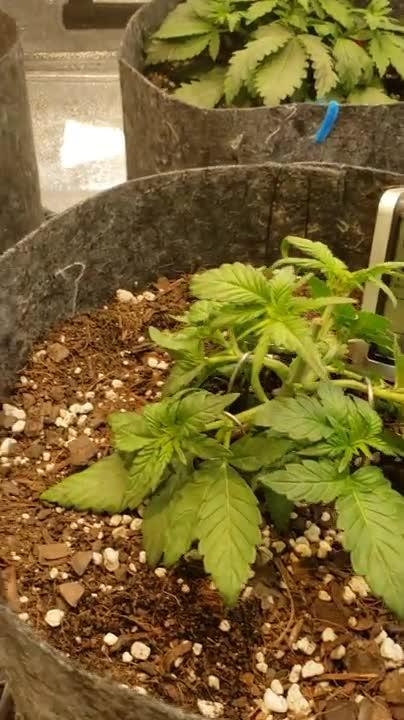The Grow Awards 2026 🏆 



































Processing
Likes
14
Share


@TegridyCal
Follow
The Pineapple Express was born and continues to grow regularly. It does not stand out for its speed but it will certainly be worthy of remembering the mythological strain.
Likes
19
Share


@DeepRootsGrowTrees
Follow
DREAM SHERBERT AUTO / KANNABIA
WEEK #9 OVERALL
WEEK #4 FLOWER
This week nothing negative to report she's looking good and healthy buds are starting to pack on some weight nice looking plant!! Stay Growing!!
Thank you for stopping by and taking a look it's much appreciated!!
Thank you KANNABIA!!
Kannabia.com SHERBERT DREAM AUTO
Likes
18
Share


@Masterchief
Follow
Week 5 :
What an exiting moment, the buds started to appear.
Apparently the the topped master KUSH is doing well, was shocked for a day but has a nice canopy promising a sufficient yield I assume?
LST still going on. Will end this week, propably Wednesday 🤔
Please let me know what you think!
28/10 update : identified CALMAG deficiency will ad curating dose.
+ bought new pH meter for more accurate testing...
Likes
17
Share


@eldruida_lamota
Follow
Venga familia que ya viene la cosecha de estas finta F1 de ZamnesiaSeeds, que ganas que tenia ya de darles machetazo, me estaban dando muchos quebraderos de cabeza.
Las flores no son para nada llamativas, una variedad más cruzada con rudelaris, que para mi gusto es perder el tiempo y el dinero invertido en cultivar cosas así… no merece la pena en interior, el ratio de gramo watio se me quedó en 0.5 , de los no peores resultados que tuve en los últimos 5 años.
a sido una genética con la que no disfruté nada cultivarla, es complicada, es bastante sensible.
Las plantas en sí se quedaron enanas y para nada fue lo que esperaba, me recordaron a las autos que plantaba en el 2012…
Agrobeta:
https://www.agrobeta.com/agrobetatiendaonline/36-abonos-canamo
Mars hydro:
Code discount: EL420
https://www.mars-hydro.com/
Hasta aquí es todo , espero que lo disfrutéis, buenos humos 💨💨.
Likes
16
Share


@MisterMaGoo
Follow
OK So had some non plant related as well as plant related issues this week.
Been hectic with personal life, and still finding my groove with the girls ..
I decided against any sort of training .... get it you can maximaxe and all but m all about letting them do their thing with some love and help, i feel like the hst and defoliation is just not for me at present time. If i get into commercial i definately see the advantages... Im growing for just myself , have zero friends and girlfriend doesnt really part take except the sometimes will hit a vape pen and shes done .. so all the fruits are for me and just do not see the need to mutalate my plants to get extra,, ill just grow more :D
Recap :
5 - Barneys Glue Gelato Autoflowers
2 - "Freebie" Caramel Cream Aut o <I believe Maine Clone Company > though did not have label.
All seeds came from AMAZING
NORTH ATLANTIC SEED COMPANY
.... ZERO issues ordering , shipping and popped 7 for 7 seeds even with some pretty disasterious goofs , see week 1
1. Struggled with Lighting - Definatly had the California Lightworks Solar Extreme TOO CLOSE .. now keeping a good 24 inches and will adjust soon with flowering
2. Struggled with PH
- My well water is great .. low PPM and 7.0 ph . BUT i use ph down it seems each day with the top off water to bring the girls down from 6.5 - 6.8 to a nice 5.9-6.0 Eariier not too bad as the girls were not drinking so much ... which leads me to next
3. THEY ARE DRINKING BOY ... Holy cow this week they became drinkers liike i did not expect. I run my lights 2 pm to 8 am and turn off until 2 pm each day .... I top off in the morning before i put them to sleep , the bigger girls ... 4 of the glue gelatos autos are drinking almost half gallon each per day atm . While my lil girls <caramel cream autos > are much shorter and i have one gelato glue auto on the smaller side . They do not drink nearly as much maybe a quart .
4. I goofed on the BLOOM, I did not expect bloom so early i was planning on this week to start them .... but nope showed signs of sulfur deficiency , caught it early and changed the feeding to bloom cycle and WOW they took the hell off ... Have TREMENDOUS growth in past week sinced changed cycle ... Again im following FAST BUDS auto feeding chart for expert for general hydro to the T and adding HYDROGUARD
5. I have one caramel cream auto with mag deficiency signs on some bpottom fan leaves but i believe i got that fixed when i did the water change, not sure why just her , unless i goofed on the bucket mix.
Which brings me to next statement ...
IM INVESTING IN A GDAM 13 GALLON x 8 bucket plus RES kit for next grow ...
Doing and maintaining 7 buckets is a royal pain in the ass . I honestly only expected 4 plants out of the 7 . AND expected fully i would kill something along the way
I am visually impaired and BRain Tumor Dude .. so i gots some issues sometimes . .. but if you check out the videos i post in a bit here you can see, WTF i am doing ok i feel like .
Great looking plants from my amateur opinion , always room for improvement as i am super critial of everything i do OCD/ADHD glorious combo
BUT YES a better setup is needed for ease of use .. I bought my complete setup at PA HYDROPONICS , meaning my BUCKETS with fittings and hydroton . 200 bucks could not find better price anywhere
he does a great fallponics custom build with 3 inch pvc that i have seen in action and tis a thing of beauty for us home growers. Plus i can add a small chiller to the mix to keep that temp a tad bit lower. IT about an 800 dollar upgrade BUT for the rest of my setup it belongs :
vivosun 4x9 tent
Ac Infinity T8 x 2 <one for vent one for blower , also have a great merv 13 filter box from ac infinity so as not to such in yuck from basement.
2 california solar extreme 550
So i figure adding an 8 bucket fallponics to fill the tent would look so much better tahn my 5 gallons and the constant checking each one and filling etc ....
Having the res would be nice I also see the cons of it as if you goof you goof on all not just one .... But i m fairly certain i will upgrade.
*****************
So right now it looks like nice buds are starting to form on all 7, the Glue Gleatos are much taller and full than the caramel creams ...
I am tracking water being added and at this rate will need another change over in a day or two if drinking 1/2 gal a day and about 3 gallons <12 liters> labout inch from bottom of net pot.
Rule of thumb being water change to replace nutes when you replace a volume equal to the total volume ... which is about every 6 days , last water change being 8/7
I will post some more when i inspect the ladies when i turn on the lights at 2 pm
First time grower in setu
Likes
7
Share


@uktuk
Follow
not much to report this week, plants are looking very healthy and happy. Struggling to keep them away from the light. stems at the base of the plants are looking beefy. So far this has been the healthiest and most vigorous looking grow I've had (aside from letting them get a little out of hand in size)
Likes
27
Share


@adam_pawloski87
Follow
What a great week it’s been!today is day 65 from seed!! One of the Forbiddin Runtz got it’s last feeding on Friday and will get flushed for 2 weeks and will be ready for dry and cure! The rest will still remain getting same dose of nutes the rest of this week and most likely into the next! This batch felt like it went so quick ! Hope you all enjoy an watch out for next week !
Likes
37
Share


@Roberts
Follow
My tiny potter is doing pretty good. It is a hard grow with the plant this size. The window for ph error is very small since it dries the potter out in a few hours. It is very root bound, and drainage is very slow. I been feeding 2 to 3 times a day if I get the chance. I got a little nute burn when I increased nutrition a little too early. The twin tops might of gotten too close to the light as it stretched. Regardless it's looking pretty good for a tiny potter. She is bulking now, still under the Mars Hydro FC4800 light. nothing much else to report. Thank you Mars Hydro. 🤜🏻🤛🏻🌱🌱🌱
Thank you grow diaries community for the 👇likes👇, follows, comments, and subscriptions on my YouTube channel👇. ❄️🌱🍻
Happy Growing 🌱🌱🌱
https://youtube.com/channel/UCAhN7yRzWLpcaRHhMIQ7X4g
Processing
Likes
Comments
Share


@Dankmark420
Follow
The girls just keeps on Living life and growing more and more for each day😍
We Saw alot of good reviews on the autopot system so we thought we would try it out🙌🏼
Likes
8
Share


@Max1973
Follow
Day 35 - few pics and vids..... everything going along nicely 👍
This is a pretty big update, so i'll add to it over the next few days, as i
finish building it all....
i'm building these 2 x SS haze, the full tent, just finishing up the setup.....
trimming them, changing solutions to 12/12 and flower.....
changed the exhaust fan and filter setup to the better outside the tent method....
and installed 12v CPU computer fan, lol ("alta9" fits in 4in ducting perfectly), drops wattage on extractor fan.... 10w tops...
got a few kg of active carbon and making/replacing the carbon filter ....
i'll add afew vids of the new setup in afew days...
Day 36 - few pics/vid of new tent setup...... "alta 9" fan :)
post tomorrow after i finish trimmin and settin up night mode etc......
and into tomorrow we go, lol ... Day 37....
slowly getting there..... little bit more to go...
this should make things abit more interesting..... right tank (short babie) has : 19 lts of tap water @18oC + 150 ml -dutch master one gold FLOWER.... 6.4 PH - 1400 PPM
left tank has : 19 lts of tap water @18oC + 50 ml of elements a and 50ml of b and 10 ml of nitro and 20ml of Crystalic (molasses/pot) .... 6.5 PH - 1200 PPM
more pics / vids of the finished tent setup.... roots, transfer, etc... Day 37 is alot of vids of the clean and change to flower.....
edit - day after build noticed left tank (nutrifield) not enough bubbles..... pulled out the 4 air pump and swapped to the 2 x original oxipumps...
much better, also to fix the problem with ph goin high, and bubbles not stirin the mix, was to add another 10ml of crystallic and another 5ml of nitro...
then pumped both tanks with ph down and set em to 5.8-6.2 - both plants have fully recovered from the big trim, and bounced back within 12-24hrs,
post pics/vid in abit.....
Day 39 - made a freaky video... was curious about what the plants would see looking up at the lights...
the lights and buzzing of air compressors and bubbling tank water, and dazzling lights turned out pretty cool in vid editor,
was in selfie mode....
and final vid of the bounceback from trim :)
👍😎
Likes
2
Share


@Bluemels
Follow
Tag 40: Ich habe die Pflanze entlaubt und ein Netz zum scroggen eingebaut. Jetzt wird es spannend wie die Pflanze das alles wegsteckt.
Likes
Comments
Share


@Kannisho
Follow
Results that inspire and motivate you to continue with many more processes.
Likes
1
Share


@SolitudeCorners
Follow
Week 3 Flower (Bloom Week 3) – Daily Tasks
Evening (Lights On)
Check environment (temp 24–27°C, RH 55–60%).
Inspect leaves and buds for pests, mold, or deficiencies.
Water/feed (depending on medium): balanced bloom nutrients with slightly higher P and K.
Ensure good airflow (oscillating fans).
Adjust plant training (light defoliation if leaves block bud sites).
Check for early signs of stretch finishing.
Evening (Before Lights Off)
Ensure irrigation is not too late in the cycle to avoid wet medium during dark period.
👉 In Week 3 bloom, the plants are finishing their stretch and starting to put more energy into forming bud sites.
Main job is: Setting Scrog net 2layers ,Control environment (VPD, airflow) ,Support the plant with bloom nutrients.
Likes
19
Share


@Dutch_Grower
Follow
We have some fasciation going on. Anyone ever experienced this before?
Likes
8
Share


@HighKing
Follow
What's up everyone ?
This week was very nice. They gained a lot of trichomes and became super sticky. I fed them the last time today. From now on they will get pure water only.
See you next week!
Likes
4
Share


@Bear_Grows_Green
Follow
12/18 start of a new week. Smelling super strong now Trichs still a lot of clear no amber yet.
12/19 watered in gallon with coconut and q
Processing
Likes
16
Share


@osmrducks
Follow
Day 22: Honestly didn't think I would have made it this far. The girls are looking great minus a couple of issues. I have over watered them and over fed too! Not to mention trying to LST too early. I will wait a bit longer before watering this time.
Day 23: MORNING - They were super dry. I have been over watering a bit so I watered maybe 1/2 gallon for all 6. I also did some more LST and took 1 large fan leaf off of each plant. I will update again before lights out.
Day 23: NIGHT - The girls are responding very well to the LST. I don't think they are liking the 80°. I am starting to have issues with lower humidity again. I need to try and figure some sort of ducting out or possibly even get a small AC unit for the grow room.
Day 24: MORNING - I removed a couple more leaves that were covering potential bud sites. I have also done a partial main-line on the smallest girl. It looks to be already showing pistols. I've had to open the tent with a big fan blowing directly in with the humidifier behind it. The girls were getting hot and dry.
Day 24: NIGHT - Well 5 are showing to be female. The biggest plant is showing no signs of sex. I am guessing it will be the mystery seed. I will be doing no more LST to these ladies for at least a week or better. I think I have stressed them out enough the past 2 days.
Day 25: These girls are very resilient!! I tortured them all weekend and the one I nopped off to do a sort of mainline grew by 20% at least.
Day 26: It is the official 3 week mark today and the girls are starting to flower. I tied em down to get light to all bud sights. I will 100% not touch them unless they need it from this point!!!! They are soo small and I need not stunt them any more!! I have removed the Mystery Seed as it looks to be a male and I do not want to take the chance!! Also fed and watered today. Only 200 ppm for the feed.
Day 27: Nothing new to report. These girls are gonna be tiny :| I must've stressed em too much too soon :( Looking good though I think! 💪
Day 28: I never do what I say. Dumb! Broke main stem on one of the best plants. Taking it as a lessons learned. It's been two hours and she looks SICK! Oh well.
Likes
2
Share


@CannaIGrow
Follow
She’s growing well and finally starting to grow
out of her lil leaf mutation at the beginning.


















